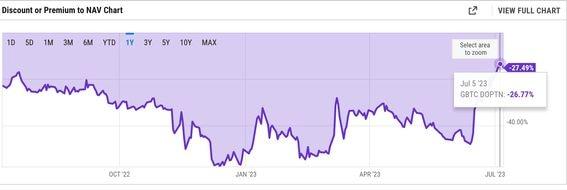
The discount to net asset value (NAV) for the $19 billion-plus Grayscale Bitcoin Trust (GBTC) continues to narrow in the wake of asset manager BlackRock’s (BLK) application to open a spot bitcoin ETF in the United States.
The discount to NAV had ballooned to nearly 50% late last year and spent most of 2023 in a range on either side of 40%, but began a steep narrowing trend following BlackRock’s mid-June filing with the U.S. Securities and Exchange Commission (SEC). It fell to as low as 26% at one point last week – the trimmest level since May 2022 – and currently sits at about 27%, according to data from Ycharts.
BlackRock’s move for a spot bitcoin (BTC) ETF set off a number of filings and re-filings for similar funds from a number of other industry actors, including from fellow asset management giant Fidelity. The moves by such powerful players have raised investor hopes that the SEC will finally approve a spot bitcoin ETF after years of rejections.
That, in turn, has fueled buying in the heavily discounted GBTC, which Grayscale nearly two years ago filed to convert to a spot bitcoin ETF. The Grayscale filing was among those SEC rejections, prompting the company to sue the agency, with a decision expected by the end of quarter three.
Lawyers for the Grayscale on Monday added to their case, with a court filing noting the SEC in late June approved a leveraged bitcoin futures-based ETF, an “even riskier” product than previously approved bitcoin futures ETFs.
While optimism for SEC approval of a spot bitcoin ETF is running high at the moment, continued investor caution could be warranted. “I had a really good laugh when we saw the BlackRock [spot bitcoin ETF] filing come out,” said Opimas CEO and founder Octavio Marenzi, appearing on CoinDesk TV Monday morning. He took note that the BlackRock fund seeks to use Coinbase (COIN) as its crypto custodian even as that exchange is facing a lawsuit from the SEC.
Grayscale and CoinDesk are both owned by Digital Currency Group.
Edited by Stephen Alpher.

